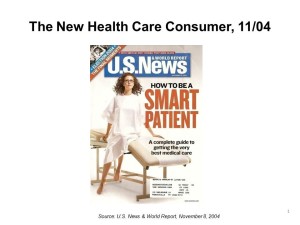 U.S. News and World Report is well-known for its Top 100 “best” lists assessing hospitals, doctors, and health plans. Watch for it to further build its position as consumer health information provider for Americans by expanding into a comprehensive health portal online.
U.S. News and World Report is well-known for its Top 100 “best” lists assessing hospitals, doctors, and health plans. Watch for it to further build its position as consumer health information provider for Americans by expanding into a comprehensive health portal online.
Advertising Age is covering the online ad dollar migration today in their publication, as well. “American companies are shifting more and more marketing dollars out of paid media. You see it happening every day as marketers—smart ones, at least—talk about things such as word-of-mouth and conversational marketing, the kind of activity that doesn’t feed the coffers of media sellers or traditional ad agencies,” according to Q207 ad sales data from TNS.
Health Populi’s Hot Points: Online health information, already consulted by nearly 120 million Americans, will continue to grow in volume and sources. The adoption of social media in health care will continue to challenge the advertising community as consumers claim more control and influence over content. The price we will pay for viewing more health information online from magazines’ health portals may be more ads sponsored by companies wanting their share of our attention. Could a TiVo-type technology soon disintermediate online advertising?
Postscript: when I checked the U.S. News Top 100 Hospitals link below, guess what popped up in the top horizontal ad space? An ad for Rozerem!
Sources: U.S. News Best Hospitals (http://health.usnews.com/sections/health/best-hospitals); Publications on Fitness and Health Head to Web (http://www.nytimes.com/2007/09/17/business/media/17hearst.html?_r=1&oref=slogin); Old-World Media Start to Feel the Pain (http://adage.com/article?article_id=120490); Source: Publications on Fitness and Health Head to Web (http://www.nytimes.com/2007/09/17/business/media/17hearst.html?_r=1&oref=slogin)




 I'm in amazing company here with other #digitalhealth innovators, thinkers and doers. Thank you to Cristian Cortez Fernandez and Zallud for this recognition; I'm grateful.
I'm in amazing company here with other #digitalhealth innovators, thinkers and doers. Thank you to Cristian Cortez Fernandez and Zallud for this recognition; I'm grateful. Jane was named as a member of the AHIP 2024 Advisory Board, joining some valued colleagues to prepare for the challenges and opportunities facing health plans, systems, and other industry stakeholders.
Jane was named as a member of the AHIP 2024 Advisory Board, joining some valued colleagues to prepare for the challenges and opportunities facing health plans, systems, and other industry stakeholders.  Join Jane at AHIP's annual meeting in Las Vegas: I'll be speaking, moderating a panel, and providing thought leadership on health consumers and bolstering equity, empowerment, and self-care.
Join Jane at AHIP's annual meeting in Las Vegas: I'll be speaking, moderating a panel, and providing thought leadership on health consumers and bolstering equity, empowerment, and self-care.